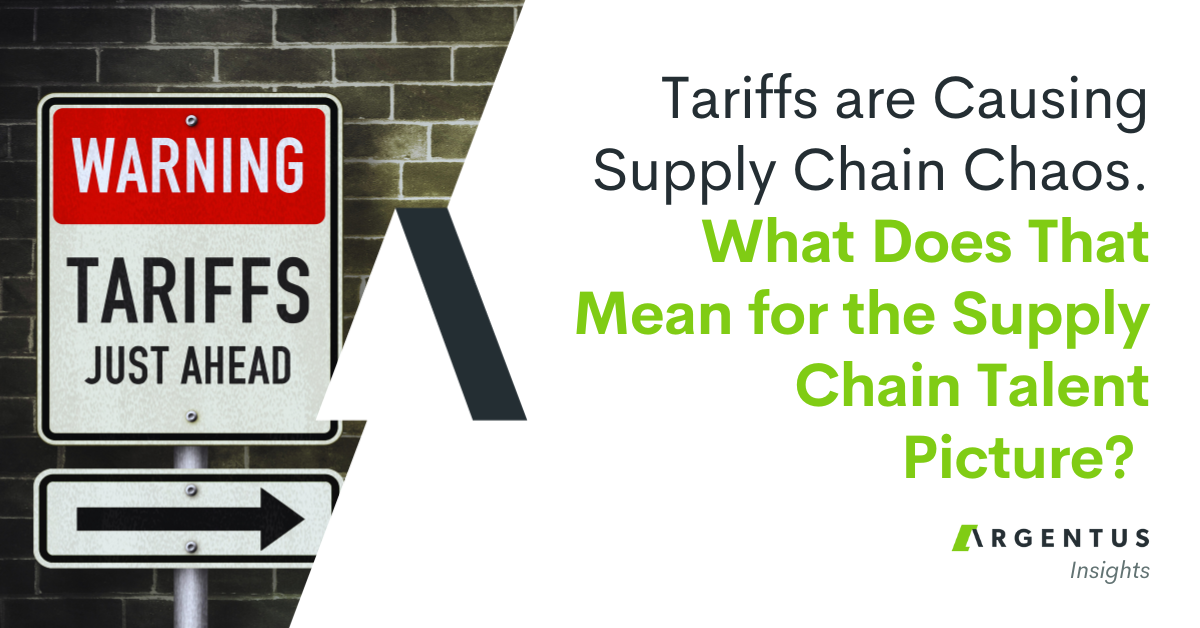New data shows the toll that two years of unprecedented pressure is taking on supply chain managers. It’s time to talk about burnout—and its impacts on workers, as well as the companies looking to hire them.
After two difficult years, we’re all experiencing some burnout. With the relentless churn of stressful headlines, anyone would be forgiven for feeling like they need a break. And in Argentus’ recruitment specialty of supply chain management, professionals are facing tremendous demands in their jobs.
In our recruitment practice, we speak with top-performing supply chain managers every day. We’re hearing more and more about how avoiding burnout is a factor driving their career decisions. We’re also hearing from more companies who are losing employees at a record clip. For example, we recently spoke with a new client who has lost fifteen people in the past eighteen months—and this is an organization without high turnover in “normal” times.
So we were struck by a recent article in Bloomberg, giving some context about just how prevalent burnout is in the field. Titled “Supply Chain Managers are Throwing in the Towel,” it explores new data that shows how burnout is causing tremendous upheaval in the supply chain job market.
Here are some of the top line takeaways from the article:
- According to LinkedIn data, supply chain professionals are quitting their jobs at a higher rate than any time since 2016. The “separation rate” for supply chain professionals went up by 28% from 2020 to 2021.
- On ZipRecruiter, job openings for supply chain professionals doubled from January of 2020 to March of 2022. This is a combination of companies creating new opportunities, but also because of labor shortages in the field.
- The article identified a lack of processes and outdated technology as a big driver of employee burnout, by making roles more arduous than they need to be. According to the VP of supply chain strategy at Coupa, 60-70% of an analytics employee’s time can be spent collecting data, rather than providing insights.
Job-related burnout is something that affects workers everywhere. But in a culture that prioritizes high performance at all costs, it’s often something that doesn’t get talked about.
Exploring why the burnout is happening in supply chain, as well as some strategies to help mitigate it, is the right thing for companies to do to support their employees. But as the data shows, managing and reducing burnout is also a sound business practice—a way to improve employee retention in a market that’s very tough for companies looking to hire.
So what is burnout?
According to the Mayo Clinic, “Job burnout is a special type of work-related stress — a state of physical or emotional exhaustion that also involves a sense of reduced accomplishment and loss of personal identity.”
While it isn’t itself a medical diagnosis, burnout has been recognized as a major problem by the World Health Organization. It often arises from a lack of control, unclear job expectations, dysfunction in the workplace, work/life imbalance, and a lack of social support. It can have major consequences including lowered workplace performance, but also fatigue, insomnia, vulnerability to illnesses like heart disease and type 2 diabetes, and more.
So what’s driving burnout in supply chain management, in particular?
In short, supply chain professionals have faced huge amounts of stress over the past two years. Not as much as healthcare workers or other front-line workers, but considerable pressure nonetheless—especially compared to some other white collar functions that have less accountability for disruptions.
Supply chain managers carry the accountability for companies’ inventory positions, many of which have been stretched to the limit. They’ve had to put out fires every day to shore up those positions and keep products moving. In many cases, they’ve arrived at the firefight with outdated technology and processes that weren’t built for the current moment. Sometimes, if the supply isn’t there, there’s nothing you can do. Yet supply chain managers are asked to deliver the impossible.
At the same time, companies have pivoted their larger supply chain strategies to deal with the disruptions. For example, in the early days of the pandemic, many companies shipping physical products to consumers raced to an eCommerce model when they hadn’t used one before—a huge (yet competitively necessary) undertaking even in normal times.
Even more companies pivoted their inventory strategies from a “just-in-time” model to one focused on resilience. That means securing new bases of supply and, in many cases, adopting completely new technology suites. Such transformations are difficult enough in normal times—but add the daily stresses that supply chain managers are under, and you have a recipe for burnout.
What’s more, while remote work has been a welcome change of pace for many, for others it’s contributed to the kind of social isolation that helps burnout fester.
In short, supply chain managers have been weathering a constant storm for the past two years that shows no sign of stopping. As recent Statscan data showed, 57% of companies currently experiencing supply chain disruptions expect them to continue for six months or more. It’s causing more supply chain professionals to leave their jobs, which presents a huge risk —as well as considerable headache—for companies.
It must be said that many employees are leaving their jobs because the past two years have created lots of supply chain job opportunities. But many are leaving because they’re simply burned out.
So what can companies do to support their employees and keep them engaged?
- Know the signs of burnout. Sometimes burnout is obvious, through an employee’s demeanour or performance. But sometimes the signs are more subtle. Decreased productivity from high performers, increased absenteeism, more sensitivity to feedback, talk about sleep issues, and disconnection from the team are some signs to look for.
- Support your staff. It’s crucial to make sure that employees’ voices are heard. If staff raise issues about mental health, take them seriously. While the supply chain stresses of the past two years are very common, it’s not enough to just say that “times are tough.” If you do, you’ll lose those employees to competitors who take their concerns seriously. There are a host of ways that companies can support staff at risk of burnout, by offering leaves, setting up workplace wellness programs, improving access to mental health resources, creating new pathways for career growth, and others. These take time and resources to set up—but in the meantime, if employees know that they’re heard, and their concerns are being addressed, it goes a long way.
- Be flexible. More and more companies successfully navigating this environment have implemented mental health leaves, as well as flexible working arrangements. Many companies have found success with a hybrid / flexible work model, where employees can work remote to avoid stressful, lengthy commutes, while also working in the office to enjoy social connection. Employees who can switch between the two often feel better supported in their mental health needs.
- Upgrade processes and systems—without putting too much more on the plate of existing staff. As we mentioned above, many supply chain managers are struggling under the burden of outdated processes and systems. Companies have used the disruptions as a business case for long-overdue upgrades to technologies. But it’s important to manage these transformations in a way that empowers employees, rather than crushing them. If you recklessly pile major transformation projects onto people who are already fighting daily fires, that’s a short road to burnout—and the failure of your project to boot.
- Hire more people. Contingent staff are excellent for the kinds of projects we mentioned above. Many companies bring on highly strategic consultants specialized in supply chain transformations to implement new technologies, processes, and improvements (such as ERP, MRP, WMS, TMS, RFID, etc.) They can manage the upgrades and transformations while you leave the day-to-day firefighting to your existing staff, who are able to provide valuable input to the transformations, and become engaged stakeholders in the process. When the project is done, the short-term consultants move on, while your staff—and your bottom line—get to enjoy increased supply chain capabilities. Beyond transformations, sometimes investing in expanding your permanent supply chain staff is the best way to make sure that your team meets the increased demands of today’s environment, without burning out.
Burnout is a huge issue for every field, but as Canada’s supply chain recruiters, we think it’s important to address it in our own little slice of the world.
We want to start conversations, and get people talking about what they’re experiencing: is burnout something that you’ve felt as a supply chain professional over the past two years? How much is it impacting your organization? Let us know in the comments!




0 Comments